Corvus constellation is located in the southern sky. Its name means “crow” or “raven” in Latin. Corvus constellation represents Apollo’s sacred bird in Greek mythology. It was first catalogued by the Greek astronomer Ptolemy in the 2nd century.
Corvus does not contain many bright stars and deep sky objects, but it is home to a very famous pair of interacting galaxies, the Antennae Galaxies. The Antennae Galaxies show a likely future of the Milky Way and Andromeda Galaxy (M31) when the two collide.
Facts, location and map
Corvus is the 70th constellation in size, occupying an area of 184 square degrees. It is located in the third quadrant of the southern hemisphere (SQ3) and can be seen from latitudes between +60° and -90°. The neighboring constellations are Crater, Hydra, and Virgo.
The constellation name Corvus is pronounced /ˈkɔːrvəs/. In English, the constellation is known as the Crow. The genitive form of Corvus, used in star names, is Corvi (pronunciation: /ˈkɔːrvaɪ/). The three-letter abbreviation, adopted by the International Astronomical Union (IAU) in 1922, is Crv.
Corvus belongs to the Hercules family of constellations, along with Aquila, Ara, Centaurus, Corona Australis, Crater, Crux, Cygnus, Hercules, Hydra, Lupus, Lyra, Ophiuchus, Sagitta, Scutum, Sextans, Serpens, Triangulum Australe, and Vulpecula.
Corvus has one star with known planets and contains no Messier objects. The brightest star in the constellation is Gienah, Gamma Corvi, with an apparent magnitude of 2.59. There is one meteor shower associated with the constellation; the Corvids.
Corvus contains four named stars. The names of stars that have been officially approved by the International Astronomical Union (IAU) are Alchiba, Algorab, Gienah, and Kraz.
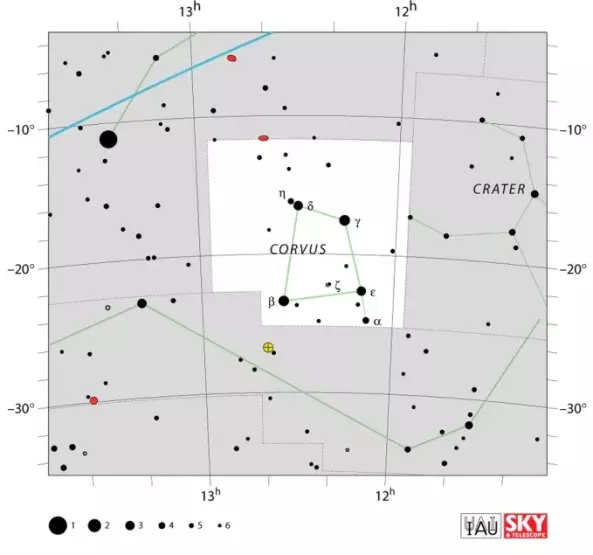
Corvus constellation map by IAU and Sky&Telescope magazine
Corvus myth
The constellation Corvus represents the raven (or crow), Apollo’s sacred bird in Greek mythology. According to the myth, the raven originally had white feathers. In one story, Apollo told the bird to watch over Coronis, one of his lovers.
Coronis gradually lost interest in Apollo and fell in love with a mortal man, Ischys. When the raven reported this to Apollo, the god was so enraged that the bird did nothing to stop it that he flung a curse on it, scorching the raven’s feathers. That, the legend goes, is why all ravens are black. Apollo then sent his sister Artemis to do away with Coronis. Before Coronis’ body was burned, the unborn child, Asclepius, was cut out of her womb and given to the centaur Chiron, who raised him. Asclepius grew up to be a famous healer and is represented by the constellation Ophiuchus, the serpent bearer.
The Greek Corvus was borrowed from the mythical Babylonian raven, MUL.UGA.MUSHEN, which was usually depicted perched on the tail of a serpent. Babylonians associated the constellation with Adad, the god of rain and storm, because its stars would rise before the rainy season, in the fall, in the second millennium.
Asterisms
Spica’s Spanker (the Sail)
The four brightest stars in Corvus – Delta, Gamma, Epsilon and Beta Corvi – form an asterism known as the Sail, or Spica’s Spanker, because the stars Gamma and Delta Corvi point the way to Spica (Alpha Virginis), the brightest star in the constellation Virgo and the 15th brightest star in the night sky.
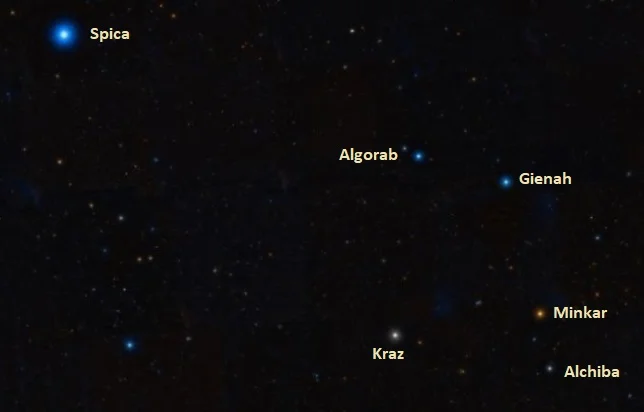
Spica’s Spanker, image: Wikisky
Corvus stars
Gienah – γ Corvi (Gamma Corvi)
Gamma Corvi is the brightest star in Corvus. It has an apparent magnitude of 2.59 and is approximately 165 light years distant. It is suspected to be a binary star.
Its traditional name, Gienah, which the star shared with Epsilon Cygni (now known as Aljanah), comes from the Arabic phrase al-janāħ al-ghirāb al-yaman, which means “the right wing of the crow.”
Gamma Corvi is a giant of the spectral type B8III.
Kraz – β Corvi (Beta Corvi)
Beta Corvi, or Kraz, is a yellow-white G-type bright giant 140 light years distant from Earth. The star’s visual magnitude varies between 2.60 and 2.66. Beta Corvi is the second brightest star in Corvus. Its proper name, Kraz, was assigned to it in modern times, but the origin of the name is uncertain. Beta Corvi has a luminosity 160 times that of the Sun.
Algorab – δ Corvi (Delta Corvi)
Delta Corvi, also known as Algorab, is a class A0 star in Corvus, approximately 87 light years distant from the solar system. It has an apparent magnitude of 3.1. The star’s traditional name comes from the Arabic word al-ghuraab, which means “the crow.”
Minkar – ε Corvi (Epsilon Corvi)
Epsilon Corvi is a K2 III class star with a visual magnitude of 3.02. It is approximately 303 light years distant. The star’s traditional name, Minkar, comes from the Arabic word almánxar, which means “the nostril of the crow.”
Alchiba – α Corvi (Alpha Corvi)
Alpha Corvi is only the fifth brightest star in the constellation. It has a visual magnitude of 4.02. It is the third faintest star with the Alpha designation in the sky, brighter only than Alkes (Alpha Crateris) and Alphecca Meridiana (Alpha Coronae Australis).
Alchiba is a class F0 dwarf or subdwarf only 48.2 light years distant. It is four times more luminous than our Sun. The star’s traditional name is derived from the Arabic al hibaa, which means “tent.” Alpha Corvi is another suspected binary star.
η Corvi (Eta Corvi)
Eta Corvi, the sixth brightest star in Corvus, is a main sequence star, a hydrogen fusing dwarf, belonging to the spectral type F2 V. It is slightly more massive and a bit younger than the Sun. It has an apparent magnitude of 4.31 and is approximately 59.4 light years distant.
Eta Corvi is similar to Vega, the brightest star in the constellation Lyra, in that it has a debris disk in its orbit. In fact, it has two. The star emits an excess of infrared radiation, significantly more than what is usually observed in an object belonging to this class.
VV Corvi
VV Corvi is a close double star composed of two stars that orbit each other with a period of 1.46 days. The system is approximately 280 light years distant. The binary also has a tertiary companion, discovered only in the last decade.
Deep sky objects in Corvus
Antennae Galaxies (NGC 4038/NGC 4039, Caldwell 60/61)
The Antennae Galaxies are a well-known pair of interacting galaxies in Corvus. They were first discovered by the German-born British astronomer Sir William Herschel in 1785. The galactic collision is currently in the starburst stage: the rate of star forming activity in the region is exceptionally high. The Antennae are sometimes also known as the Ring Tail galaxy.
The Antennae Galaxies belong to the NGC 4038 group, a group of galaxies that consists of between 13 and 27 members located in the constellations Corvus and Crater.
The colliding galaxies got named the Antennae because their shape resembles that of an insect’s antennae. They have two long tails comprised of gas, dust and stars ejected from their main bodies as a result of the interaction.
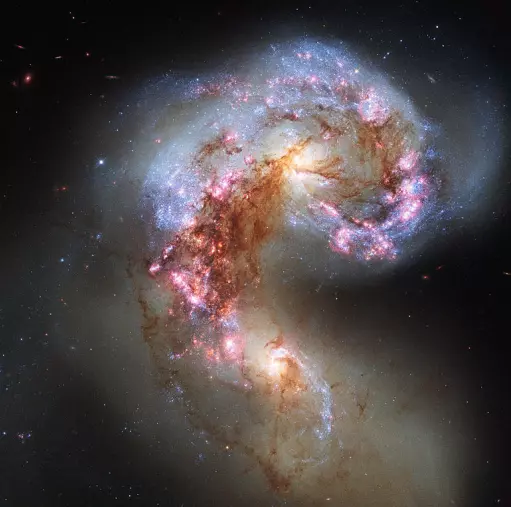
This image of the Antennae Galaxies shows obvious signs of chaos. Clouds of gas are seen in bright pink and red, surrounding the bright flashes of blue star-forming regions — some of which are partially obscured by dark patches of dust. The rate of star formation is so high that the Antennae Galaxies are said to be in a state of starburst, a period in which all of the gas within the galaxies is being used to form stars. This cannot last forever and neither can the separate galaxies; eventually the nuclei will coalesce, and the galaxies will begin their retirement together as one large elliptical galaxy. Image: ESA/Hubble & NASA
The Antennae Galaxies have an apparent magnitude of 11.2/11.1 and are 45 million light years distant from Earth. Two supernovae have been observed in the galaxies in recent years: SN 2004GT and SN 2007 sr.
The Antennae were separate galaxies about 1.2 billion years ago. NGC 2038 is believed to have been a barred spiral and NGC 2039, a spiral galaxy. The two approached each other approximately 900 million years ago and they passed through each other about 600 million years ago. They started ejecting stars some 300 million years ago and now the arcs of ejected stars have grown so large that they appear as the antennae, an extension of the colliding pair. The nuclei of the two galaxies are expected to merge into a single core within the next 400 million years, and the pair will eventually most likely settle into the form of an elliptical galaxy.
NGC 4027 (Arp 22)
NGC 4027 is a barred spiral galaxy in Corvus. It has a visual magnitude of 11.7 and is about 83 million light years distant from the solar system. The galaxy is a peculiar one: one of its spiral arms extends further outwards than the other, possibly as a result of a past collision with another galaxy.
NGC 4027 is also a member of the NGC 4038 group of galaxies. It is located less than a degree southwest of the Antennae Galaxies.
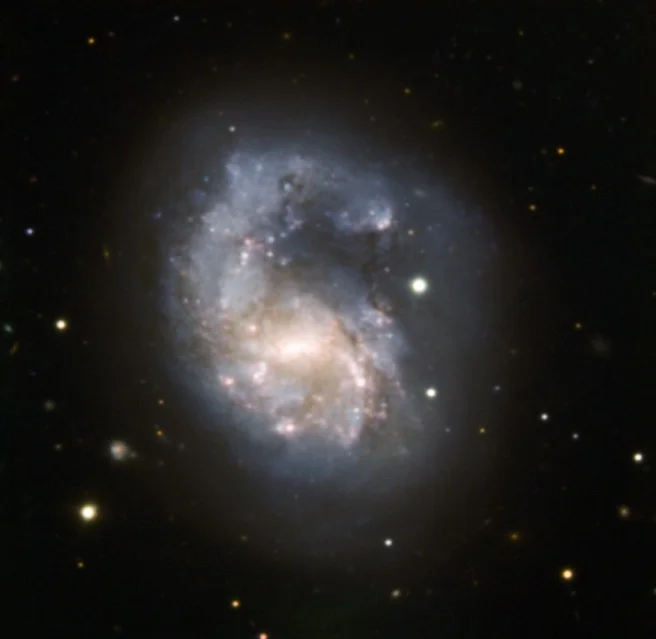
NGC 4027, also known as Arp 22, stretches its single extended spiral arm in this face-on image. Located about 75 million light-years away in the constellation of Corvus (the Crow), this barred spiral galaxy is identified as a peculiar galaxy by this extended arm, thought to be the result of a collision with another galaxy millions of years ago — most likely a small galaxy known as NGC 4027A. NGC 4027 is part of the NGC 4038 Group, a group of galaxies that also contains the famous distorted couple known as the Antennae Galaxies. Image: ESO
NGC 4361
NGC 4361 is a large planetary nebula located in the centre of the constellation. Its shape is similar to that of a dim elliptical galaxy. The nebula is about 50’’ in diameter and surrounds a 13th magnitude star.
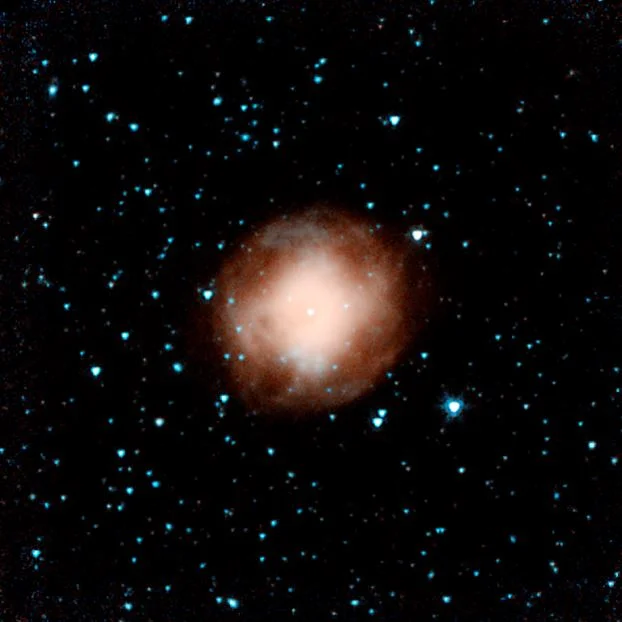
This infrared picture shows a star in its final stages, called NGC 4361. This star was once a lot like our sun, before it evolved and puffed out its outer layers. The object, called a planetary nebula, is unusual in that is has four lobes, or jets, of ejected material instead of the standard two. Astronomers suspect the there might be two stars inside the nebula, each producing a bipolar jet. Orange primarily shows heated gas. This image is one of the first to be taken during Spitzer’s warm mission — a new phase that began after the telescope, which operated for more than five-and-a-half years, ran out of liquid coolant. The picture was snapped with the two infrared channels that still work at Spitzer’s still-quite-chilly temperature of 30 Kelvin (about minus 406 Fahrenheit). The two infrared channels are part of Spitzer’s infrared array camera: 3.6-micron light is blue and 4.5-micron light is orange. This picture was taken while the telescope was being re-commissioned, on July 18. Image: NASA/JPL-Caltech